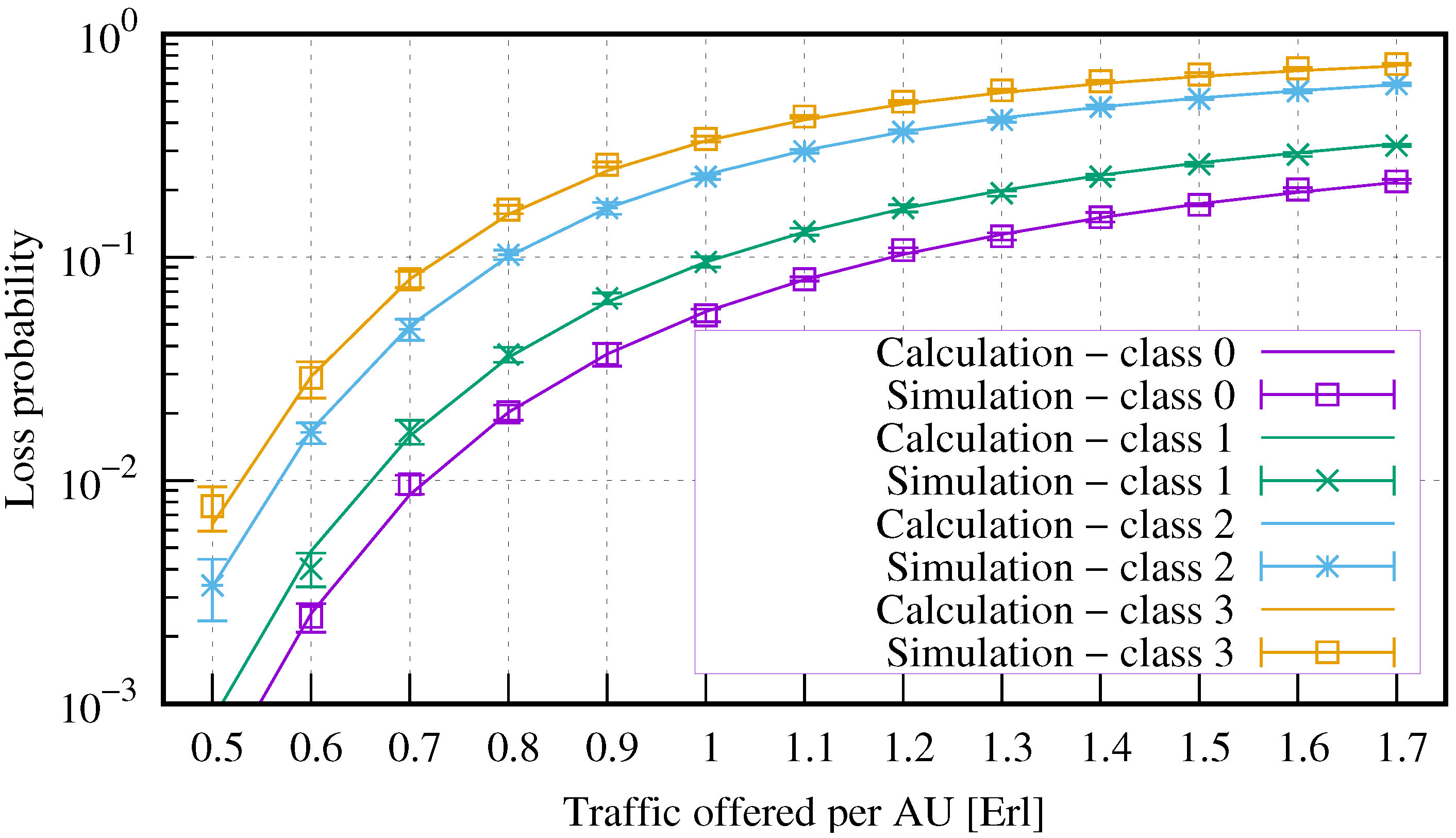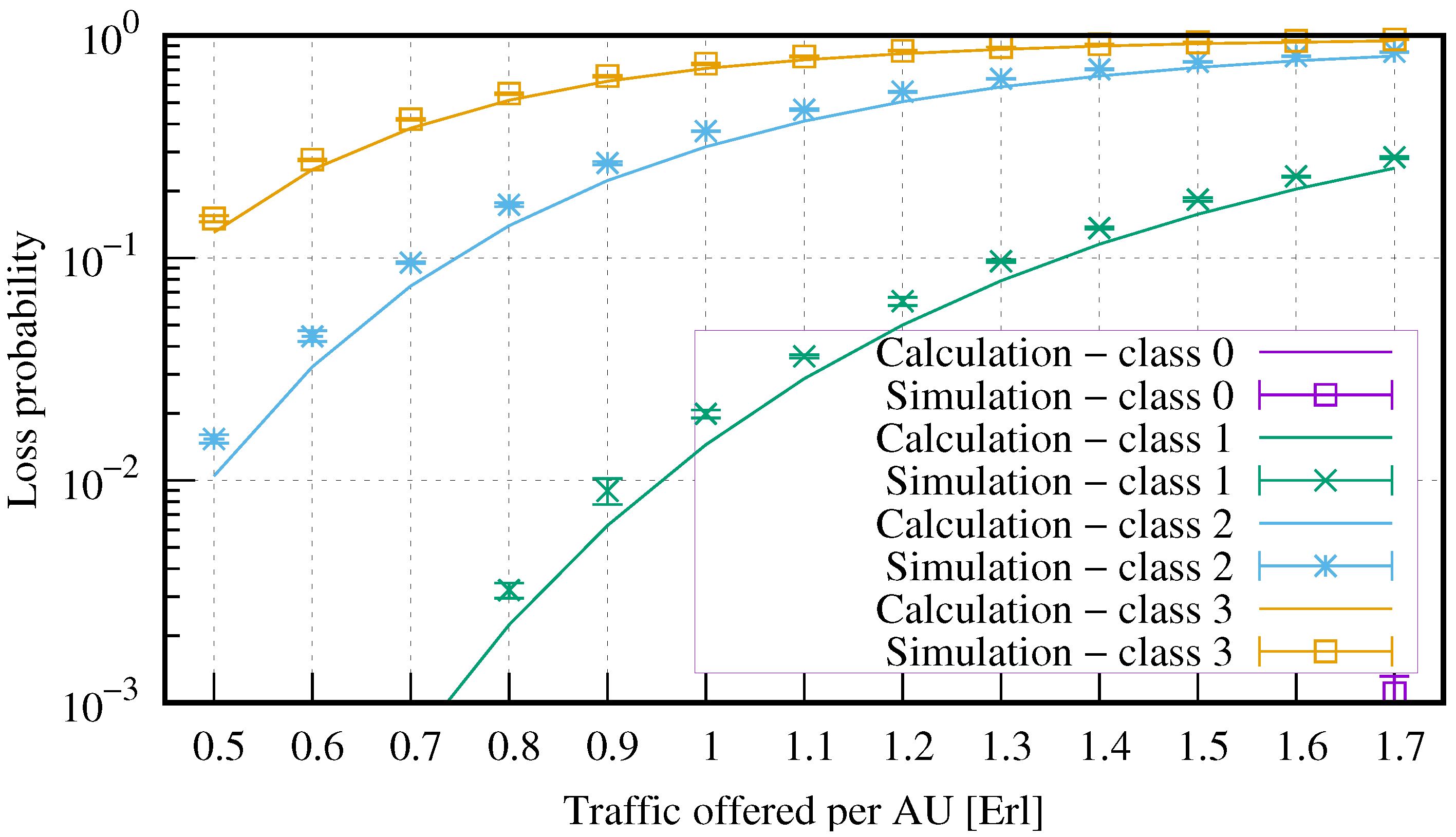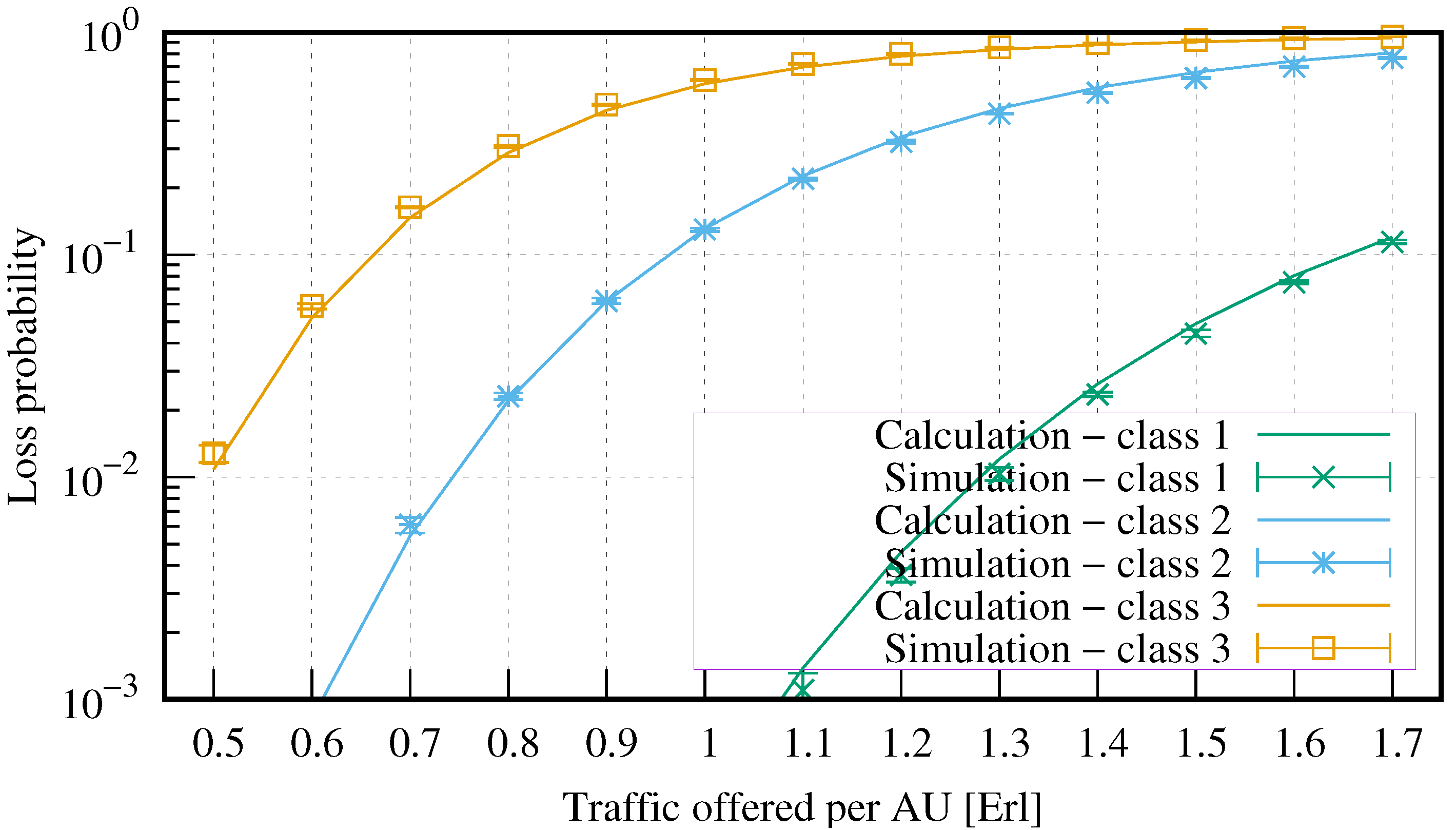A New Model of the Limited Availability Group with Priorities for Multi-Service Networks
Abstract
1. Introduction
2. A New Analytical Model of the Link
2.1. Limited-Availability Group
2.2. Model of the LAG with Priorities
- Handling calls from lower-priority classes does not affect the blocking probability of calls from higher-priority classes.
- In the event of insufficient resources, the arrival of a new call with a higher priority leads to the termination of service for currently serviced calls with lower priorities.
- Introduction of data on the traffic offered: sets of classes of individual traffic types , , with appropriate parameters: , , for Engset traffic (), and Pascal traffic (), and Poisson traffic , ().
- Determination of initial blocking probability value in a system with c priorities .
- Determination of the initial number of traffic classes serviced in the system .
- Determination of the value of blocking probabilities in a non-priority system servicing c traffic classes
- Determination of the value of blocking probabilities in a non-priority system servicing traffic classes
- Calculation of the value of the blocking probability of class c in the system with priorities:, where is the blocking probability of class c in a system carrying c traffic classes.
- Decreasing the number of traffic classes: .
- If , then steps 5–7 are repeated. If , the algorithm ends.
3. Numerical Results
- System 1 (only Poisson traffic; non-priority system)AUs, , AUs, AUs, AUs, AUs.
- System 2 (only Poisson traffic; with priorities; the smaller the AU call, the higher the priority):AUs, , AUs, AUs, AUs, AUs.
- System 3 (only Poisson traffic; with priorities; the smaller the AU call, the higher the priority):AUs, , AUs, AUs, AUs, AUs.
- System 4 (BPP traffic; non-priority system):AUs, , AUs, AUs, AUs, AUs. A total of 250 traffic sources for Engset and Pascal classes.
- System 5 (BPP traffic; with priorities, the smaller the AU call, the higher the priority):AUs, , AUs, AUs, AUs, AUs. A total of 250 traffic sources for Engset and Pascal classes.
4. Conclusions
Author Contributions
Funding
Data Availability Statement
Conflicts of Interest
References
- Dwivedi, Y.K.; Hughes, L.; Baabdullah, A.; Ribeiro-Navarrete, S.; Giannakis, M.; Al-Debei, M.; Dennehy, D.; Metri, B.; Buhalis, D.; Cheung, C.; et al. Metaverse beyond the hype: Multidisciplinary perspectives on emerging challenges, opportunities, and agenda for research, practice and policy. Int. J. Inf. Manag. 2022, 66, 102542.1–102542.55. [Google Scholar] [CrossRef]
- Kowalik, K.; Andruloniw, P.; Partyka, B.; Zwierzykowski, P. Telecom Operator’s Approach to QoE. J. Telecommun. Inf. Technol. 2022, 2, 26–34. [Google Scholar] [CrossRef]
- Andruloniw, P.; Kowalik, K.; Partyka, B.; Zwierzykowski, P. Multi-Layer QoE Learning System Implemented by Fiberhost. Appl. Sci. 2023, 13, 2300. [Google Scholar] [CrossRef]
- Nowak, B.; Piechowiak, M.; Stasiak, M.; Zwierzykowski, P. An analytical model of a system with priorities servicing a mixture of different elastic traffic streams. Bull. Pol. Acad. Sci. Tech. Sci. 2020, 68, 263–270. [Google Scholar] [CrossRef]
- Glabowski, M.; Sobieraj, M.; Stasiak, M. Modelling Limited-Availability Groups with BPP Traffic and Bandwidth Reservation. In Proceedings of the 2009 Fifth Advanced International Conference on Telecommunications, Venice/Mestre, Italy, 24–28 May 2009; pp. 89–94. [Google Scholar] [CrossRef]
- Sobieraj, M.; Stasiak, M.; Weissenberg, J.; Zwierzykowski, P. Single hysteresis model for limited-availability group with BPP traffic. J. Telecommun. Inf. Technol. 2013, 3, 89–96. [Google Scholar]
- Sobieraj, M.; Stasiak, M.; Zwierzykowski, P. Model of the Threshold Mechanism with Double Hysteresis for Multi-service Networks. In Proceedings of the Computer Networks: Computer Networks: 19th International Conference, CN 2012, Szczyrk, Poland, 19–23 June 2012; Kwiecień, A., Gaj, P., Stera, P., Eds.; Springer: Berlin/Heidelberg, Germany, 2012; pp. 299–313. [Google Scholar]
- Sobieraj, M.; Zwierzykowski, P.; Leitgeb, E. Determination of Traffic Characteristics of Elastic Optical Networks Nodes with Reservation Mechanisms. Electronics 2021, 10, 1853. [Google Scholar] [CrossRef]
- Sobieraj, M.; Zwierzykowski, P.; Leitgeb, E. Modelling and Optimization of Multi-Service Optical Switching Networks with Threshold Management Mechanisms. Electronics 2021, 10, 1515. [Google Scholar] [CrossRef]
- Vlasakis, M.; Keramidi, I.; Moscholios, I.; Sarigiannidis, P.; Logothetis, M. A Call Admission Control Mechanism based both on Queueing and the Probabilistic Bandwidth Reservation Policy in Mobile Hotspots. In Proceedings of the 2022 Panhellenic Conference on Electronics & Telecommunications (PACET), Tripolis, Greece, 2–3 December 2022; pp. 1–6. [Google Scholar] [CrossRef]
- Keramidi, I.P.; Vardakas, J.S.; Ramantas, K.; Moscholios, I.; Verikoukis, C. Computational Load Management Strategies in Cell-Free-Based, Converged-Optical-Wireless 6G Networks. In Proceedings of the ICC 2023—IEEE International Conference on Communications, Rome, Italy, 28 May–1 June 2023; pp. 5316–5321. [Google Scholar] [CrossRef]
- Logothetis, M.; Moscholios, I. Efficient Multirate Teletraffic Loss Models beyond Erlang; John Wiley & Sons, Ltd.: Hoboken, NJ, USA, 2019. [Google Scholar] [CrossRef]
- Stasiak, M.; Glabowski, M.; Wisniewski, A.; Zwierzykowski, P. Modeling and Dimensioning of Mobile Wireless Networks: From GSM to LTE; John Wiley & Sons, Ltd.: Hoboken, NJ, USA, 2010. [Google Scholar]
- Wei, D.; Zheng, D.; Yang, L.; Cai, R. Low earth orbit satellite admission control scheme based on deep Q-learning. In Proceedings of the 2023 3rd International Conference on Neural Networks, Information and Communication Engineering (NNICE), Guangzhou, China, 24–26 February 2023; pp. 89–92. [Google Scholar] [CrossRef]
- Awasthi, C.; Nawal, M.; Kumar Mishra, P. Fuzzy Logic Based Hybrid Approach CAC Scheme in 5G. In Proceedings of the 2021 5th International Conference on Information Systems and Computer Networks (ISCON), Mathura, India, 22–23 October 2021; pp. 1–6. [Google Scholar] [CrossRef]
- Imole, O.E.; Walingo, T. Multimedia Call Admission Control for Mobile Terminals in Geostationary Satellite Networks. In Proceedings of the 2019 IEEE AFRICON, Accra, Ghana, 25–27 September 2019; pp. 1–4. [Google Scholar] [CrossRef]
- Delgado, O.; Jaumard, B. Joint admission control and resource allocation with GoS and QoS in LTE uplink. In Proceedings of the 2010 IEEE Globecom Workshops, Miami, FL, USA, 6–10 December 2010; pp. 829–833. [Google Scholar] [CrossRef]
- Kim, Y.; Pack, S.; Lee, W. Mobility-Aware Call Admission Control Algorithm in Vehicular WiFi Networks. In Proceedings of the 2010 IEEE Global Telecommunications Conference GLOBECOM 2010, Miami, FL, USA, 6–10 December 2010; pp. 1–5. [Google Scholar] [CrossRef]
- Perros, H.; Elsayed, K. Call admission control schemes: A review. IEEE Commun. Mag. 1996, 34, 82–91. [Google Scholar] [CrossRef]
- Zwierzykowski, P. Modeling Traffic Management Mechanisms in Multi-Service Mobile Networks. Ph.D. Thesis, Poznań University of Technology, Poznań, Poland, 2014. (In Polish). [Google Scholar]
- Parniewicz, D.; Stasiak, M.; Zwierzykowski, P. Traffic engineering for multicast connections in multiservice cellular networks. IEEE Trans. Ind. Inform. 2013, 9, 262–270. [Google Scholar] [CrossRef]
- Stasiak, M.; Sobieraj, M.; Weissenberg, J.; Zwierzykowski, P. Analytical model of the single Treshold mechanism with hysteresis for multi-service networks. IEICE Trans. Commun. 2012, e95-b, 120–132. [Google Scholar] [CrossRef]
- Parniewicz, D.; Stasiak, M.; Zwierzykowski, P. Multicast Connections in Mobile Networks with Embedded Threshold Mechanism. In Proceedings of the Computer Networks—18th Conference, CN 2011, Ustron, Poland, 14–18 June 2011; Kwiecien, A., Gaj, P.S., Eds.; Springer: Berlin/Heidelberg, Germany, 2011; Volume 160, pp. 407–416. [Google Scholar] [CrossRef]
- Stasiak, M.; Wiewióra, J.; Zwierzykowski, P. Analytical Model of the WCDMA Radio Interface in UMTS Network with User Differentiation. In Proceedings of the 5th Advanced International Conference on Telecommunications (AICT09), Venice, Italy, 24–28 May 2009; pp. 83–88. [Google Scholar] [CrossRef]
- Głąbowski, M.; Sobieraj, M. Simulation Studies of Link Group in Elastic Optical Networks Used in Internet of Things Solutions. Transp. Telecommun. 2023, 24, 278–287. [Google Scholar] [CrossRef]
- Głąbowski, M.; Sobieraj, M.; Stasiak, M. Analytical Model of a Single Link of Elastic Optical Networks. IEEE Access 2022, 10, 90200–90212. [Google Scholar] [CrossRef]
- Sobieraj, M.; Zwierzykowski, P.; Leitgeb, E. Simulation Studies of Elastic Optical Networks Nodes with Multicast Connections. Hum.-Centric Comput. Inf. Sci. 2022, 12, 05-1–05-13. [Google Scholar] [CrossRef]
- Głąbowski, M.; Sobieraj, M.; Stasiak, M.; Leitgeb, E. Analytical Modeling of Switching Fabrics of Elastic Optical Networks. IEEE Access 2020, 8, 193462–193477. [Google Scholar] [CrossRef]
- Głąbowski, M.; Ivanov, H.; Leitgeb, E.; Sobieraj, M.; Stasiak, M. Simulation studies of elastic optical networks based on 3-stage Clos switching fabric. Opt. Switch. Netw. 2020, 36, 100555. [Google Scholar] [CrossRef]
- Gerstel, O.; Jinno, M.; Lord, A.; Yoo, S.B. Elastic optical networking: A new dawn for the optical layer? IEEE Commun. Mag. 2012, 50, S12–S20. [Google Scholar] [CrossRef]
- Tomkos, I.; Azodolmolky, S.; Solé-Pareta, J.; Careglio, D.; Palkopoulou, E. A tutorial on the flexible optical networking paradigm: State of the art, trends, and research challenges. Proc. IEEE 2014, 102, 1317–1337. [Google Scholar] [CrossRef]
- Kabacinski, W.; Abdulsahib, M.; Michalski, M. Wide-Sense Nonblocking W-S-W Node Architectures for Elastic Optical Networks. IEICE Trans. Commun. 2019, 102-B, 978–991. [Google Scholar] [CrossRef]
- Abuelela, E.; Zal, M.; Kabacinski, W. Simultaneous Connections Routing in Wavelength-Space-Wavelength Elastic Optical Switches. Sensors 2023, 23, 3615. [Google Scholar] [CrossRef]
- Kabaciński, W. Nonblocking Electronic and Photonic Switching Fabrics; Springer: Berlin/Heidelberg, Germany, 2005. [Google Scholar]
- Stasiak, M. Effective Availability in Switching Networks Modeling Issues; Monography; Poznań University of Technology: Poznań, Poland, 2005. (In Polish) [Google Scholar]
- Zhu, R.; Zhao, Y.; Yang, H.; Yu, X.; Tan, Y.; Zhang, J.; Wang, N.; Jue, J.P. Multi-dimensional resource assignment in spatial division multiplexing enabled elastic optical networks with multi-core fibers. In Proceedings of the 2016 15th International Conference on Optical Communications and Networks (ICOCN), Hangzhou, China, 24–27 September 2016; pp. 1–3. [Google Scholar] [CrossRef]
- Klinkowski, M.; Zalewski, G.; Jaworski, M.; Perello, J.; Spadaro, S. Performance Evaluation of Multi-Core Fiber-based Dynamic Spectrally and Spatially Flexible Optical Network with Limited Transceiver Resources. In Proceedings of the 2019 21st International Conference on Transparent Optical Networks (ICTON), Angers, France, 9–13 July 2019; pp. 1–4. [Google Scholar] [CrossRef]
- Parniewicz, D.; Stasiak, M.; Wiewióra, J.; Zwierzykowski, P. An Approximate Model of the WCDMA Interface Servicing a Mixture of Multi-rate Traffic Streams with Priorities. In Computer Performance Engineering: 5th European Performance Engineering Workshop, EPEW 2008, Palma de Mallorca, Spain, 24–25 September 2008; Thomas, N., Juiz, C., Eds.; Springer: Berlin/Heidelberg, Germany, 2008; pp. 168–180. [Google Scholar]
- Delbrouck, L. A Unified Approximate Evaluation of Congestion Functions for Smooth and Peaky Traffics. IEEE Trans. Commun. 1981, 29, 85–91. [Google Scholar] [CrossRef]
- Delbrouck, L. The Uses of Kosten’s Systems in the Provisioning of Alternate Trunk Groups Carrying Heterogeneous Traffic. IEEE Trans. Commun. 1983, 31, 741–749. [Google Scholar] [CrossRef]
- Delbrouck, L. On the Steady-State Distribution in a Service Facility Carrying Mixtures of Traffic with Different Peakedness Factors and Capacity Requirements. IEEE Trans. Commun. 1983, 31, 1209–1211. [Google Scholar] [CrossRef]
- Głąbowski, M.; Hanczewski, S.; Stasiak, M.; Weissenberg, J. Modeling Erlang’s ideal grading with multi-rate BPP traffic. Math. Probl. Eng. 2012, 2012, 456910. [Google Scholar] [CrossRef]
- Stasiak, M. An approximate model of a switching network carrying mixture of different multichannel traffic streams. IEEE Trans. Commun. 1993, 41, 836–840. [Google Scholar] [CrossRef]
- Stasiak, M.; Wiewióra, J.; Zwierzykowski, P. The Analytical Model of the WCDMA interface with priorities in the UMTS network. In Proceedings of the International Symposium on Information Theory and its Applications (ISITA2008), Auckland, New Zealand, 7–10 December 2008. [Google Scholar]
- Stasiak, M.; Wiewióra, J.; Zwierzykowski, P. WCDMA Interface in UMTS Network Carrying a Mixture of Multi-rate Traffic with Different Priorities. In Proceedings of the International Conference on Telecommunications, Marrakech, Maroco, 25–27 May 2009; pp. 265–270. [Google Scholar]
- Katzschner, L.; Scheller, R. Probability of loss of data traffics with different bit rates hunting one common PCM-channel. In Proceedings of the 8th International Teletraffic Congress, Melbourne, Australia, 10–17 November 1976; pp. 1–8. [Google Scholar]





| System 1 | System 2 | |||||||
|---|---|---|---|---|---|---|---|---|
| Traffic Offered per AU | Class 0 | Class 1 | Class 2 | Class 3 | Class 0 | Class 1 | Class 2 | Class 3 |
| 0.5 | 0.000489 | 0.000960 | 0.003393 | 0.007651 | 0 | 0 | 0.000121 | 0.012376 |
| 0.6 | 0.002453 | 0.004032 | 0.016402 | 0.028782 | 0 | 0 | 0.001988 | 0.056719 |
| 0.7 | 0.009631 | 0.016580 | 0.047611 | 0.079639 | 0 | 0 | 0.011921 | 0.153557 |
| 0.8 | 0.020189 | 0.036634 | 0.102531 | 0.163669 | 0 | 0 | 0.046728 | 0.290932 |
| 0.9 | 0.036855 | 0.065531 | 0.166246 | 0.260294 | 0 | 0.000140 | 0.096612 | 0.441738 |
| 1 | 0.054956 | 0.095250 | 0.229738 | 0.339402 | 0 | 0.000645 | 0.166803 | 0.569067 |
| 1.1 | 0.079904 | 0.130211 | 0.297546 | 0.426394 | 0 | 0.002482 | 0.248342 | 0.685357 |
| 1.2 | 0.107519 | 0.165765 | 0.365356 | 0.497615 | 0 | 0.008136 | 0.339614 | 0.773264 |
| 1.3 | 0.123995 | 0.193064 | 0.412988 | 0.558602 | 0 | 0.021132 | 0.428309 | 0.827772 |
| 1.4 | 0.151303 | 0.229327 | 0.470740 | 0.612932 | 0 | 0.041786 | 0.517523 | 0.876802 |
| 1.5 | 0.172070 | 0.260863 | 0.513384 | 0.658750 | 0 | 0.085979 | 0.606375 | 0.912321 |
| 1.6 | 0.200672 | 0.288353 | 0.553988 | 0.701787 | 0 | 0.143762 | 0.682968 | 0.931384 |
| 1.7 | 0.218456 | 0.316838 | 0.595331 | 0.733178 | 0 | 0.182986 | 0.746483 | 0.949185 |
| System 4 | System 5 | |||||||
|---|---|---|---|---|---|---|---|---|
| Traffic Offered per AU | Class 0 | Class 1 | Class 2 | Class 3 | Class 0 | Class 1 | Class 2 | Class 3 |
| 0.5 | 0.000451 | 0.001274 | 0.002839 | 0.005998 | 0 | 0 | 0.000124 | 0.013104 |
| 0.6 | 0.002569 | 0.004551 | 0.016006 | 0.029894 | 0 | 0 | 0.001521 | 0.051729 |
| 0.7 | 0.009874 | 0.016545 | 0.048886 | 0.082628 | 0 | 0 | 0.009219 | 0.160706 |
| 0.8 | 0.021216 | 0.035137 | 0.096804 | 0.154802 | 0 | 0 | 0.038084 | 0.298639 |
| 0.9 | 0.037274 | 0.063856 | 0.168057 | 0.254337 | 0 | 0.000118 | 0.089283 | 0.420095 |
| 1 | 0.058505 | 0.095201 | 0.231580 | 0.345200 | 0 | 0.000807 | 0.156461 | 0.570705 |
| 1.1 | 0.081005 | 0.129102 | 0.298970 | 0.423327 | 0 | 0.002982 | 0.224193 | 0.672637 |
| 1.2 | 0.102057 | 0.158636 | 0.360382 | 0.489238 | 0 | 0.008908 | 0.323356 | 0.767958 |
| 1.3 | 0.125368 | 0.194632 | 0.416966 | 0.555587 | 0 | 0.021835 | 0.415358 | 0.825324 |
| 1.4 | 0.148029 | 0.223292 | 0.463023 | 0.606918 | 0 | 0.040766 | 0.501172 | 0.872552 |
| 1.5 | 0.170954 | 0.256535 | 0.509360 | 0.651006 | 0 | 0.071198 | 0.580838 | 0.908226 |
| 1.6 | 0.190738 | 0.280468 | 0.554094 | 0.691370 | 0 | 0.123248 | 0.664392 | 0.930823 |
| 1.7 | 0.216747 | 0.307260 | 0.590674 | 0.726290 | 0 | 0.166805 | 0.722270 | 0.948625 |
Disclaimer/Publisher’s Note: The statements, opinions and data contained in all publications are solely those of the individual author(s) and contributor(s) and not of MDPI and/or the editor(s). MDPI and/or the editor(s) disclaim responsibility for any injury to people or property resulting from any ideas, methods, instructions or products referred to in the content. |
© 2024 by the authors. Licensee MDPI, Basel, Switzerland. This article is an open access article distributed under the terms and conditions of the Creative Commons Attribution (CC BY) license (https://creativecommons.org/licenses/by/4.0/).
Share and Cite
Nowak, B.; Zwierzykowski, P. A New Model of the Limited Availability Group with Priorities for Multi-Service Networks. Electronics 2024, 13, 1174. https://doi.org/10.3390/electronics13071174
Nowak B, Zwierzykowski P. A New Model of the Limited Availability Group with Priorities for Multi-Service Networks. Electronics. 2024; 13(7):1174. https://doi.org/10.3390/electronics13071174
Chicago/Turabian StyleNowak, Błażej, and Piotr Zwierzykowski. 2024. "A New Model of the Limited Availability Group with Priorities for Multi-Service Networks" Electronics 13, no. 7: 1174. https://doi.org/10.3390/electronics13071174
APA StyleNowak, B., & Zwierzykowski, P. (2024). A New Model of the Limited Availability Group with Priorities for Multi-Service Networks. Electronics, 13(7), 1174. https://doi.org/10.3390/electronics13071174







